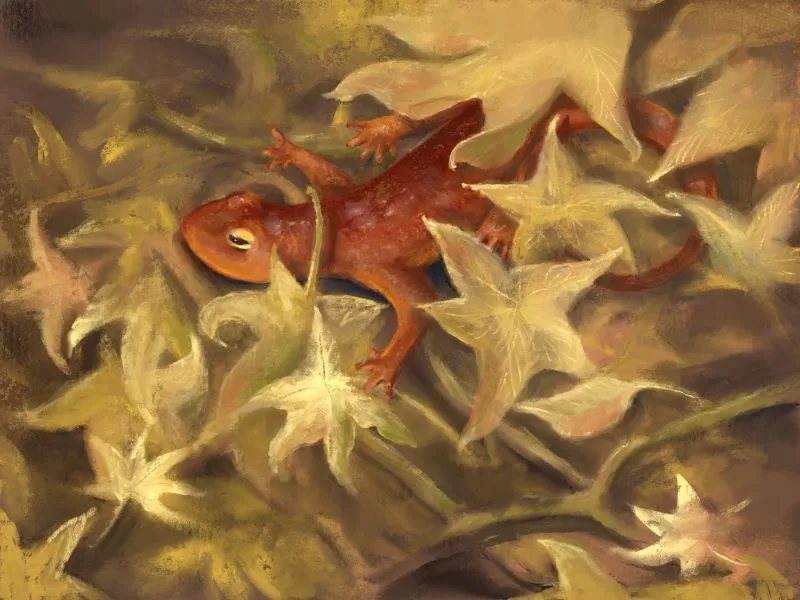
“What kind of beast is your salamander?” asked the Prince.
“It is hard to tell their kind, your Honor,” said Golg. “For they are too white-hot to look at. But they are most like small dragons. They speak to us out of the fire. They are wonderfully clever with their tongues: very witty and eloquent…”
—C.S. Lewis, The Silver Chair
The salamander was on the patio, where the bricks were cool and damp. Unlike author C.S. Lewis’ salamanders, which were inspired by medieval legends, the local Santa Monica Mountains species are small and cold and mostly silent. Instead of dwelling in fire, they live their lives in moist earth, or under logs or leaf litter. But they are in a way dragon-like and mysterious, cryptic species dwelling unseen and in the quiet dark all their long and mysterious lives.
There are five species of salamander in the Santa Monica Mountains. They are all survivors from the last Ice Age, left behind on this island of cooler, wetter habitat, as the climate warmed. Today, these species face a new climate crisis, but they are survivors.
It’s far more common to see newts and salamanders during the rainy season, but the long wet winter and unexpected late summer rain has resulted in some unexpected sightings this year during what is usually a rare time for amphibian encounters.
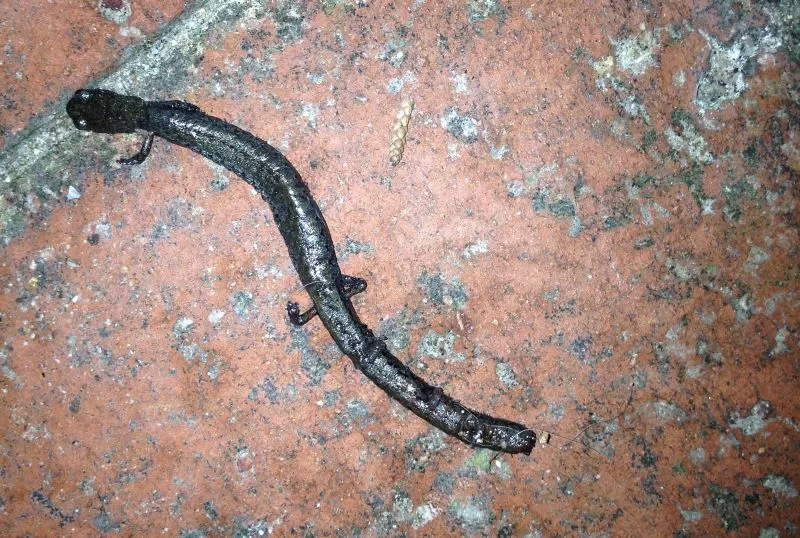
The salamander on the patio was probably Batrachoseps nigriventris, the black-bellied slender salamander. Although they are rarely seen, this is the most common member of the family in the Santa Monica Mountains. These small amphibians live alongside humans, quite literally underfoot. Slender salamanders spend most of their lives in the soil. An individual may travel no more than a few yards during its entire lifetime.
Slender salamanders usually retreat underground to aestivate during the dry season, only reemerging after the first rains. This one was taking advantage of the unexpected summer rain to forage or perhaps seek a new refuge. Unlike many other amphibians, slender salamanders do not have an aquatic larval phase, but although they live on land, they are members of the family Plethodontidae—lungless salamanders that breathe through their skin.
Slender salamanders do not have an aquatic life phase. They hatch from the egg as miniature versions of their parents.
Adults are rarely more than three inches long. They have short, almost vestigial limbs, and a body shape and texture that enable them to pass themselves off as worms, unless the observer takes a second look and notices their tiny limbs and beady eyes.
During the rainy season, Batrachoseps can be found in cool damp places: under plant pots, stones, dead leaves or even in the cracks between garden paving materials. Immediately after a rain, they may turn up on the patio or driveway, or at the bottom of a swimming pool—a plight that is usually fatal, unless someone fishes them out. The rest of the time they remain underground in tunnels made by the species they prey on—small invertebrates like worms and grubs.
This species is thought to have arrived in their current range by riding the Pacific tectonic plate up from southern latitudes over the course of millions of years. They seem to be adapting to life in urban gardens, but like all amphibians, they are sensitive to pesticides and vulnerable to habitat loss and climate change.
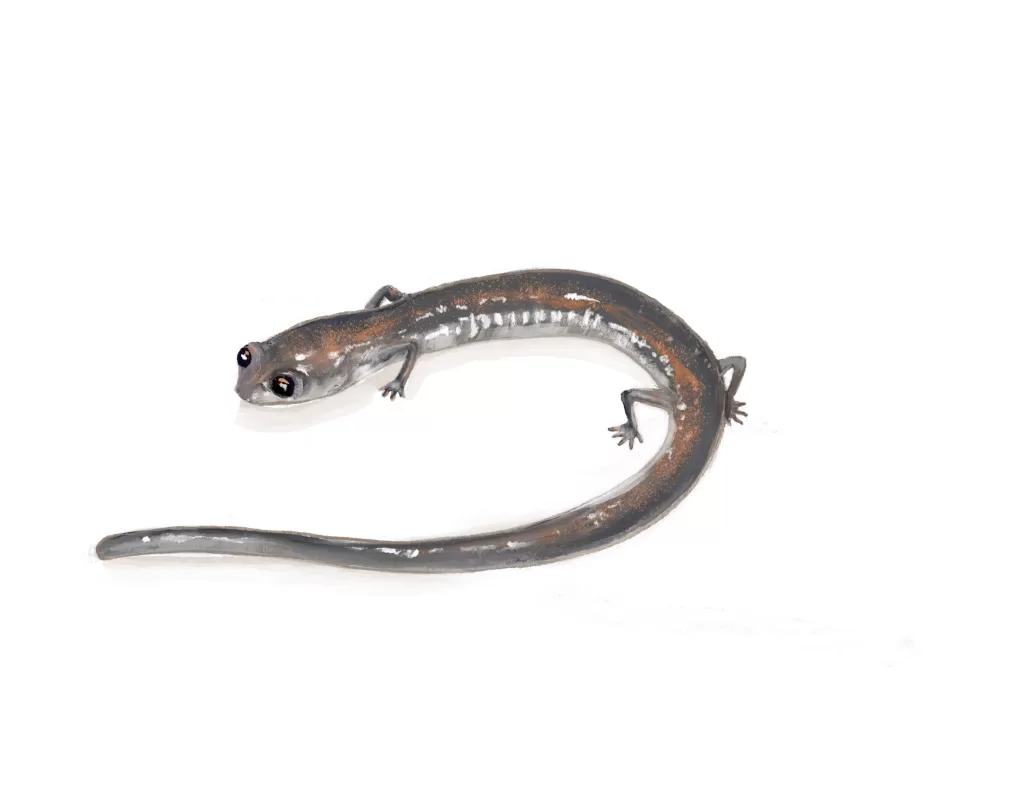
A second species of slender salamander, Batrachoseps major, the Southern California slender salamander, also lives in the Santa Monica Mountains. Surprisingly little is known about these animals, but genetic testing has revealed an astonishing eight “deeply differentiated, geographically cohesive mitochondrial subclades” of Batrachoseps distributed throughout Southern California, according to a 2020 study.
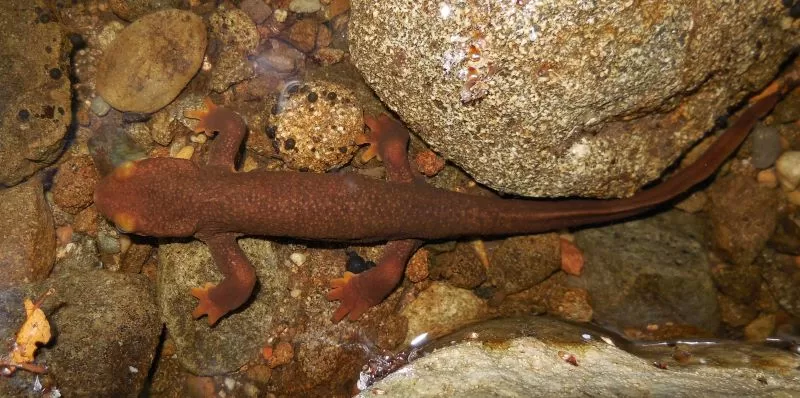
If slender salamanders are common but rarely seen, the California newt, Taricha torosa, is increasingly rare but easily the most conspicuous local salamander species. At the right time of year it can be a vivid orange color and it looks like a robust, medium-sized lizard, but it isn’t. The California newt is the only native member of the salamander family in the Santa Monica Mountains that is born in water, developing legs, gills and finally lungs during a tadpole-like larval phase. It then becomes air-breathing and terrestrial, spending most of its adult life in leaf litter, where it hunts for small invertebrates. During mating season in the spring, this secretive amphibian returns to the water to mate, breathing through its skin during its adult aquatic phase.
Newts need clean, clear water to successfully breed. Habitat loss and water impacts from development, agriculture, and wildfires have landed this charismatic amphibian on the California species of special concern list. They are also a special concern species in the Santa Monica Mountains National Recreation Area, and their presence here is limited to the least disturbed watersheds.
Slender salamanders rely on not being seen, and they can detach their tails in an effort to avoid predators. The California newt has a much more effective defense mechanism. When it is threatened, it can secrete a powerful neurotoxin that can incapacitate and even kill most potential predators. Known as tetrodotoxin, this biological weapon is the same type of neurotoxin found in pufferfish.
A single California newt is said to contain enough toxin to kill approximately 12 humans.
The toxin is only fatal if ingested, but it can enter the body through cuts or broken skin, reportedly causing a burning sensation followed by numbness. It’s not surprising that California newts only have a couple of natural predators. Garter snakes have a tolerance to the toxin and prey on adult newts. The larvae of some species of dragonfly and caddisfly consume newt eggs and newt larvae. Adult newts will also sometimes consume larvae of their own species.
While tetrodotoxin protects California newts from most native predators, it doesn’t deter invasive species like crawfish, bullfrogs and mosquito fish, which eat newt eggs and larvae. Crawfish also have a reputation for attacking adult newts.
Neurotoxin is also not a protection from the two biggest threats to newts: habitat loss and pollution. Roads create another major problem, separating adult newts from the water source they are drawn back to during breeding season, and preventing young newts from dispersing.
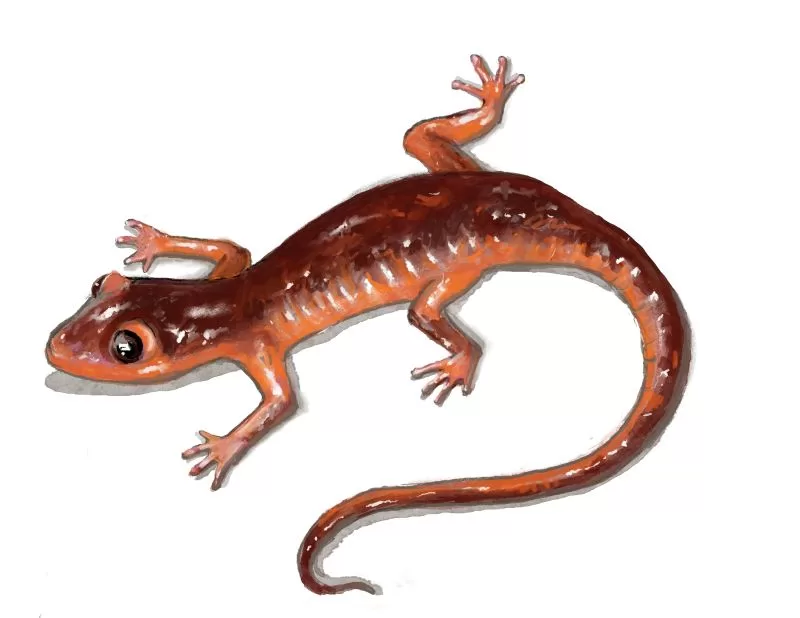
There are two additional members of the salamander family in the Santa Monica Mountains: the Monterey Ensatina, Ensatina eschscholtzii eschscholtzii, and the arboreal salamander, Aneides lugubris. Although they are listed as occurring throughout the Santa Monica Mountains, one is far more likely to encounter these two species in Topanga, which frequently receives more rain than many of the surrounding areas, and still retains extensive oak groves—essential habitat for both species.
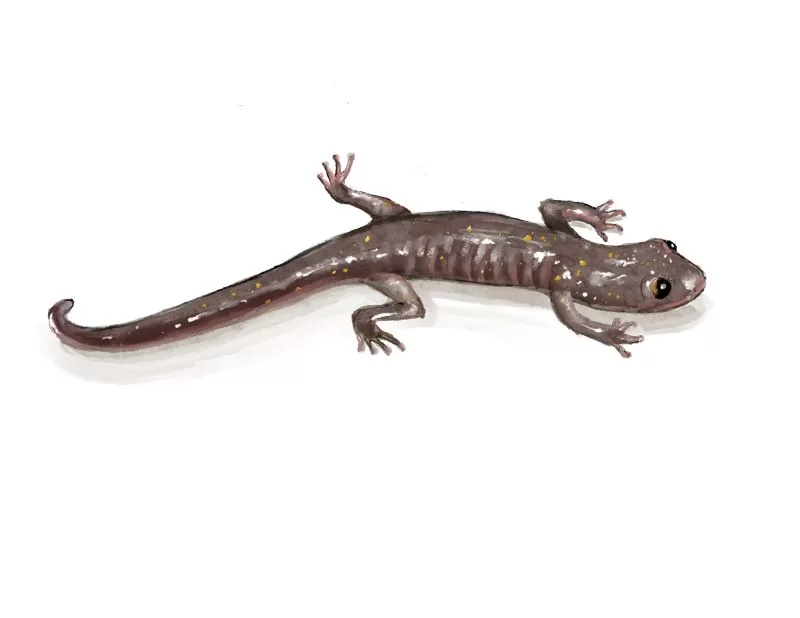
Like the slender salamander, both of these species are lungless and breathe through their skin. They are also entirely terrestrial. The arboreal salamander is a good climber and can turn up in the treetops, especially during rainy weather, but it is far more likely to be found in tree cavities, under the bark of decaying logs or stumps, or foraging under the leaf litter.
Its skin is rubbery and ranges from gray and brown to purplish, sometimes with golden spots. Arboreal salamanders are small, astonishingly fast, and good at not being seen. They aestivate during the dry season, only emerging when there is sufficient moisture.
Arboreal salamanders stay with their eggs, guarding and protecting them until the young have hatched, and they have surprisingly formidable teeth for an amphibian, shaped like minuscule shards of glass, and sharp enough to draw blood. They use them to tackle prey like centipedes, as well as for defense, and they have been observed scraping fungi from decaying wood, although it is unclear if they use it for food, or a source of moisture.
With its flame-colored legs and tail, the Monterey Ensatina truly does suggest a small dragon. The Ensatina can produce a milky, toxic secretion from its tail when threatened, but it is nowhere near as potent a deterrent as the newt’s neurotoxin. This beautiful but fragile amphibian depends mostly on staying out of sight for survival, hunting and sheltering in rotting wood, leaf litter and old animal burrows. Although it is a documented resident, it’s rarely seen.
Most encounters with a salamander occur in the garden, but salamanders do occasionally wander into the house. Gently scooping them up and placing them outside is the best option. These are fragile and highly sensitive animals, so keeping contact to a minimum is important. It’s also important to thoroughly wash hands after handling any member of this family, but even the California newt’s powerful neurotoxin is only a hazard if ingested. We can all help these species by avoiding pesticides, never dumping anything into creeks and streams, and by leaving the leaf litter that collects under oaks and other native trees undisturbed—provided it is far enough away from the house that it isn’t a fire hazard.
Many longtime residents of the Santa Monica Mountains have never encountered a salamander, but these ancient and remarkable survivors from a wetter, cooler epoch, still live in our mountains, sometimes as close by as the patio outside the back door.
In the mythology of several California Native American cultures salamanders had the power to protect the purity of the water they lived in. These small amphibians are still an indicator of stream health and their presence remains a good omen.












